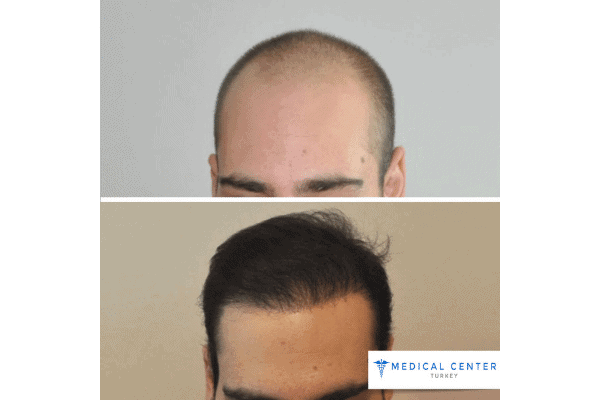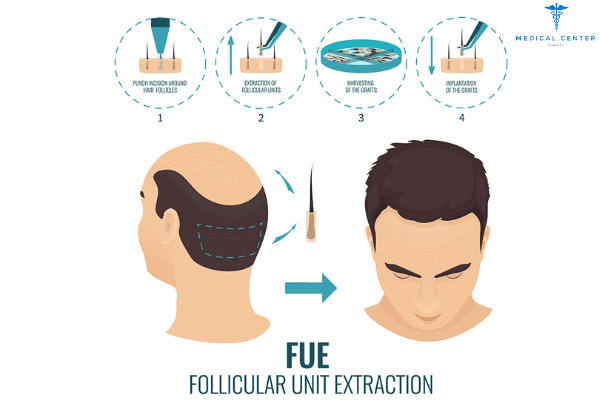DHI vs. FUE: Hair Transplant Procedures
DHI vs. FUE: Hair Transplant Procedures is an article that aims to give you all the information you do not know about DHI vs. FUE: Hair Transplant Procedures and its process. We kindly shared the main headings with you;
- What is FUE and what kind of procedure does FUE have?
- What is DHI and what kind of procedure does DHI have?
- What is the difference between FUE and DHI?
- Which procedures are right for me?
- What are the results of DHI and FUE procedures?
- What are the advantages of DHI and FUE hair transplant procedures in Turkey?
- DHI and FUE hair transplants procedures in Turkey summary (Price, Duration Time, Hospitalization)
- Why should you choose Turkey for hair transplantation?
DHI and FUE have frequently used hair transplant methods, but you may not be sure which method is a better option for you. There is a lot of information on this subject on the internet, but some of this information may not reflect the truth or may complicate your work. To help you and understand which method will give you better results, we will talk about the differences between DHI (Direct Hair Implantation) and FUE (Follicular Unit Extraction).
In DHI vs. FUE: Hair Transplant Procedures article, we have included what DHI and FUE treatments are, how they work, and the differences between them. First of all, you can see what DHI and FUE are and how they follow the procedure below.
What is FUE and what kind of procedure does FUE have?
FUE hair transplant surgery is a very popular surgery today and is preferred by many patients. Instead of the classical technique of FUT (or Follicular Unit Transplantation), where a strip of skin is removed to collect the grafts, FUE grafts are made directly from the scalp. The most important factor in choosing the FUE technique is that it leaves no visible marks and provides natural-looking results.
As the first step in FUE hair transplant surgery, groups of 1-4 hair follicles, commonly known as grafts, are manually removed one by one and placed in a storage solution. Then, when the extraction phase is completed, the doctor opens the channels using micro blades. These channels opened by the doctor are the holes or slits where the grafts are placed. After the channels are opened, the doctor removes the grafts from the solution and implants them in the recipient area.
The different types of hair transplant techniques: Follicular Unit Extraction (FUE), Follicular Unit Transplantation (FUT), and Robotic Hair Transplant.
The benefits and risks of hair transplantation: Potential for restored hair growth, natural-looking results, but also risks like scarring, infection, and unrealistic expectations.
The factors that influence the cost of hair transplants: Technique used, surgeon’s experience, location of the clinic, and the number of grafts needed.
The recovery process after hair transplantation: What to expect in terms of discomfort, swelling, and results over time.
Patients who have completed FUE hair transplant surgery may notice the first results about two months after the transplant. On the other hand, for more noticeable growths, it usually becomes more noticeable after six months and full results usually appear 12-18 months after the procedure.
It can be said that the most obvious advantages of FUE hair transplantation are faster recovery time and less discomfort since there are no stitches. For this reason, FUE hair transplantation is the more preferred procedure because it promises better results, less pain/discomfort, no scarring and more effect. Fue hair transplantation can last a lifetime, so regardless of FUE or FUT, the most important point in hair transplantation is to maintain the characteristics of donor hair follicles and ensure healthy growth.
What is DHI and what kind of procedure does DHI have?
DHI hair transplant surgery is a newer procedure compared to FUE and is similar to the FUE technique, that is, it does not leave a scar after the surgery and provides a natural appearance. The difference between these two procedures is that although the graft removal process of DHI is similar to FUE, there are a few differences that should be noted.
As a first step, the hair follicles are removed one by one using a specialist tool with a diameter of 1 mm or less. In the next step, the hair follicles are loaded into an implant device known as the Choi Implanter Pen and the procedure is performed by implanting them directly into the recipient area. During the DHI procedure, the creation of the channels and the implantation are completed at the same time. With Choi Implanter Pen, it gives more sensitivity to the doctor while implanting the hair follicles. At the same time, it provides more comfortable control of the angle, direction and depth of the newly transplanted hair. Also, recovery time for DHI is similar to FUE. It usually takes 12-18 months for full results to appear.
During FUE, a surgeon manually cuts a series of channels in your scalp to place hair follicles. DHI technique is a procedure that helps surgeons make these incisions and also transplant hair, and DHI and FUE prevent the long scarring caused by FUT, but these surgeries usually take longer and are more expensive.You can easily request a personalized treatment plan and receive your free quote by clicking the image below.


What Is the Difference Between FUE and DHI?
DHI vs. FUE hair transplant procedures explained, the most important difference between DHI and FUE is the way the grafts are implanted in the recipient area, for example, during FUE hair transplantation, the channels must be opened before implantation so that the surgeon can manually implant the extracted grafts. However, DHI uses a special tool known as the Choi Implanter Pen, so it is performed immediately after extraction, without the need to create channels for the grafts first, during the implantation phase.You can easily request a personalized treatment plan and recieve your free quote by clicking the image below.In addition, Follicular unit extraction is a graft collection method, in this process, micro-motor tools were used to open the holes where the hair was placed in the canal, and the name of the transplantation technique was defined as FUE.


Which procedures are right for me?
The DHI procedure is a newer procedure compared to FUE, and DHI is usually recommended for patients younger than 35 years of age. The reason for this is that hair loss in individuals under the age of 35 is not very advanced and the success rates of these cases are much higher compared to other age groups.
The FUE procedure is a surgery that is considered safe with minor possible side effects such as small white scars from which the follicles are removed. Although it is not observed very often in the FUE procedure, infection or tissue death may occur at the site of the surgery. On the other hand, the maximum number of grafts we implant with DHI surgery is 4000.
The DHI Hair Transplantation method also allows you to determine the direction and dimensions of hair growth according to your preference, and the other advantage of DHI is that it does not require canal drilling. The FUE method can be preferred as it covers larger areas than the DHI method, and the DHI method is a process that provides a good rate to obtain higher density. They stated that according to the recommendations of the experts, the success rate of both FUE and DHI reached 95%. This proves that whichever procedure you want to have, both procedures are extremely safe.
What are the results of DHI and FUE procedures?
FUE Hair Transplantation results are highly dependent on the opening of the channels. In other words, if the channels are opened correctly, the success rate of your hair transplant procedure will be much higher. As a result of FUE hair transplant surgery, you will achieve more natural-looking and dense hair. If every stage of the FUE hair transplant procedure is performed correctly, you will have very effective and natural-looking results in the results of your hair transplant treatment thanks to this method. It will take approximately six months for you to notice the results when your FUE hair transplant surgery is completed, and you need to wait approximately twelve months after the operation before you can observe the full result.
DHI hair transplant surgery is a very effective treatment for people looking for natural-looking hair transplant methods. After the implantation procedure is completed, you will not experience any hair loss and your hair will be with you forever. The most important advantage of the DHI hair transplant procedure is that it gives full control over the angle, depth, and placement of the hair, and it achieves results that look absolutely natural.


The common result of these two procedures is that the full results begin to appear twelve months after the treatment. In addition, the recovery time is shorter and similar for both procedures.
The age range of people who will prefer hair transplant surgery is also important. Every individual over the age of 18 can have hair transplant surgery, but the advice of experts is that people aged 25 and over should have a hair transplants. Younger men may not have to opt for hair transplantation yet, as their hair loss patterns may not be fully determined yet.
What are the advantages of DHI and FUE hair transplant procedures in Turkey?
Turkey is among the countries that are most preferred for hair transplant surgery and perform the hair transplant process in the best way. Surgeons in Turkey perform 250 hair replacements almost every day. Patients from all over the world come to Turkey for hair transplantation and most of these patients are from Israel, UAE, Saudi Arabia, and European countries.
Turkish clinics follow international standards and provide high-quality services. It is approved by national and international medical organizations such as JCI (Joint Commission International) health institutions in Turkey. Also, 34 medical centers in Turkey are accredited by JCI, which is double that of Israel or Germany.
Turkey is one of the most preferred countries in terms of medical tourism and because of this, it attracts 1 million medical tourists to the country annually thanks to the cost-effective services in Turkey. Due to the average price policy in the country, DHI hair transplant and FUE hair transplant prices in Turkey are approximately 70% more affordable than in Europe. Clinics in Turkey offer special packages that include all necessary services at affordable prices.
Plastic surgeons in Turkey have more than 10 years of successful experience in their field and perform many DHI and FUE operations in order to achieve better results and prevent side effects.


The prices of DHI and FUE hair transplantation in Turkey will vary depending on the clinic and the surgeon’s experience. The cost of hair transplant surgery in Turkey starts from $1,550 and can reach up to $3,400. Turkish health clinics offer DHI and FUE hair transplant packages for all the needs of the patient, and standard packages generally include:
- consultation with a hair transplant specialist
- blood tests
- DHI and FUE hair planting itself
- all the medications and consumables
- hair wash
- barber service
- post-op care
- accommodation (usually in a hotel)
- airport-clinic-airport transfers
- language assistance
If you want to have DHI and FUE hair transplant surgeries in Turkey, there are a few important issues you should consider while searching for the most suitable clinic for you.
For example, the accreditation and certification of the center are important because it is essential that the best hair transplant clinics have permission and legal evidence to do this procedure. Doctors’ experience is another important factor because the number of surgeries a doctor performs shows you have the best chance of achieving the desired result. When choosing the doctor who will perform your surgery, choose the specialist with more than 10 years of experience and look at this surgeon’s portfolio so that you can be sure of the doctor who will help you achieve the results you want.
It is also important to examine the success rates because this index helps you see how many people experience complications or side effects after DHI and FUE hair transplantation in a particular clinic. Research the experiences and comments of people who have had hair transplantation in Turkey before, because these patients’ comments share their experiences about DHI and FUE hair transplantation in Turkey, and what they have experienced in these comments, so you can understand whether hair transplantation is suitable for you.


Why should you choose Turkey for hair transplantation?
Choosing Turkey for hair transplantation offers several compelling advantages that have made the country a top destination for medical tourism. Here are some key reasons:
- World-Class Surgeons: Turkey is home to highly skilled and experienced surgeons who are internationally recognized for their expertise. Many of these professionals have trained and worked in leading medical institutions around the world, bringing a wealth of knowledge and cutting-edge techniques to their practices.
- State-of-the-Art Facilities: Turkish clinics and hospitals are equipped with the latest medical technologies and adhere to high standards of safety and hygiene. Many facilities are accredited by international organizations, ensuring that patients receive top-quality care.
- Affordable Prices: One of the most significant advantages of choosing Turkey for hair transplantation is the cost. Procedures in Turkey are often significantly more affordable than in countries like the United States or Western Europe, without compromising on quality. This cost-effectiveness allows patients to access premium care at a fraction of the price they would pay elsewhere.
- Comprehensive Care Packages: Turkish medical tourism agencies and clinics often offer all-inclusive packages that cover not just the surgery itself, but also accommodation, transportation, and post-operative care. This convenience allows patients to focus on their recovery without worrying about logistical details.
- Fast Access to Treatment: Unlike in many Western countries where waiting times for elective surgeries can be long, Turkey offers faster access to treatment. Patients can often schedule their procedures with minimal delay, making the process more efficient and convenient.
- Cultural and Historical Appeal: Beyond the medical benefits, Turkey is a country rich in history and culture. Patients can combine their medical journey with a chance to explore iconic sites like Istanbul’s Hagia Sophia, Cappadocia’s fairy chimneys, or the stunning beaches along the Aegean and Mediterranean coasts.
- High Patient Satisfaction: Many patients who choose Turkey for hair transplantation report high levels of satisfaction with their results. The combination of skilled surgeons, advanced techniques, and personalized care contributes to successful outcomes and positive experiences.
These factors make Turkey an attractive choice for anyone considering hair transplantation, offering a blend of quality, affordability, and convenience that is hard to match elsewhere.
If you want to learn more and get support, you can always contact us. The link you can reach for a free consultation is located below. It won’t take much of your time.





